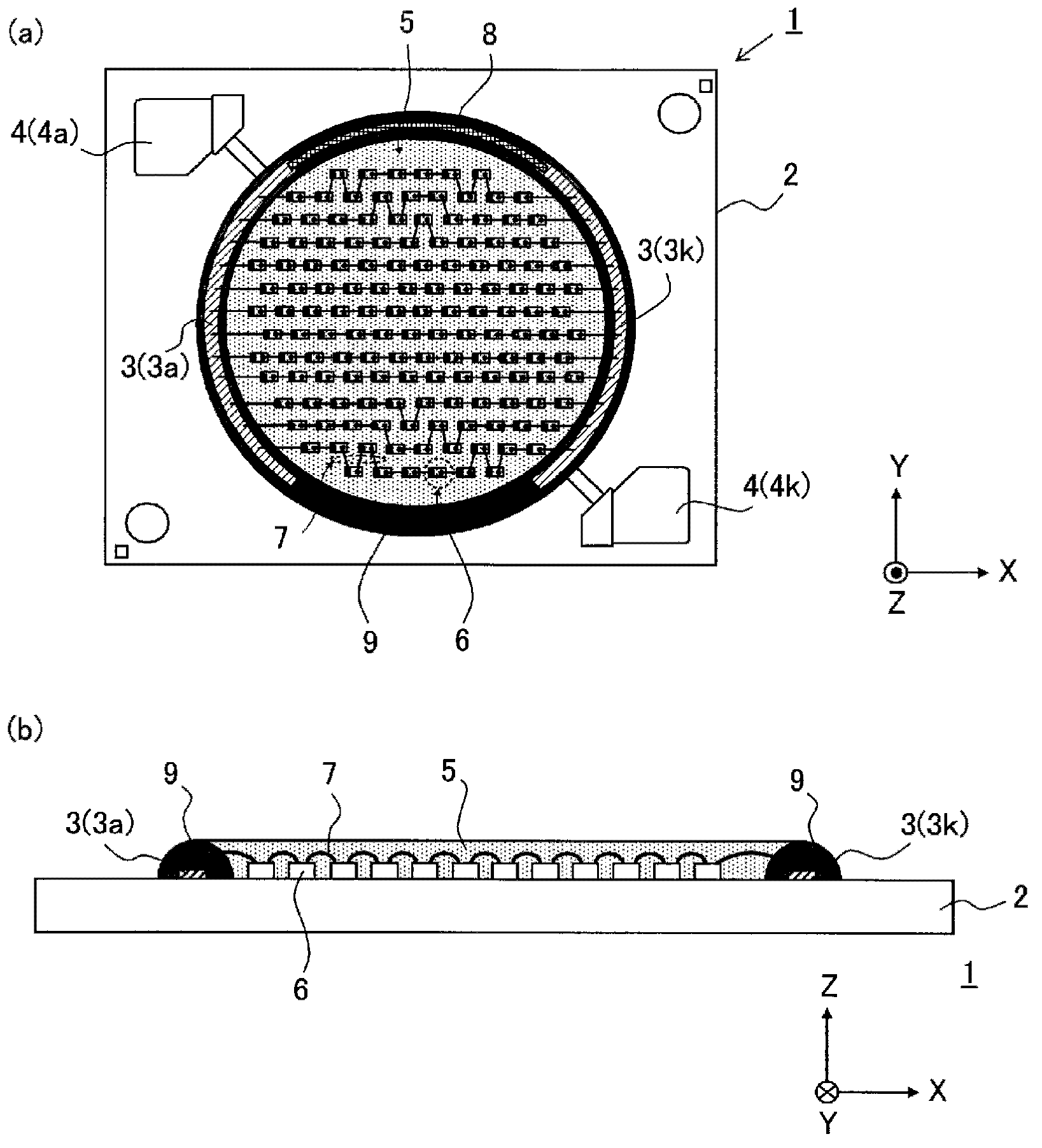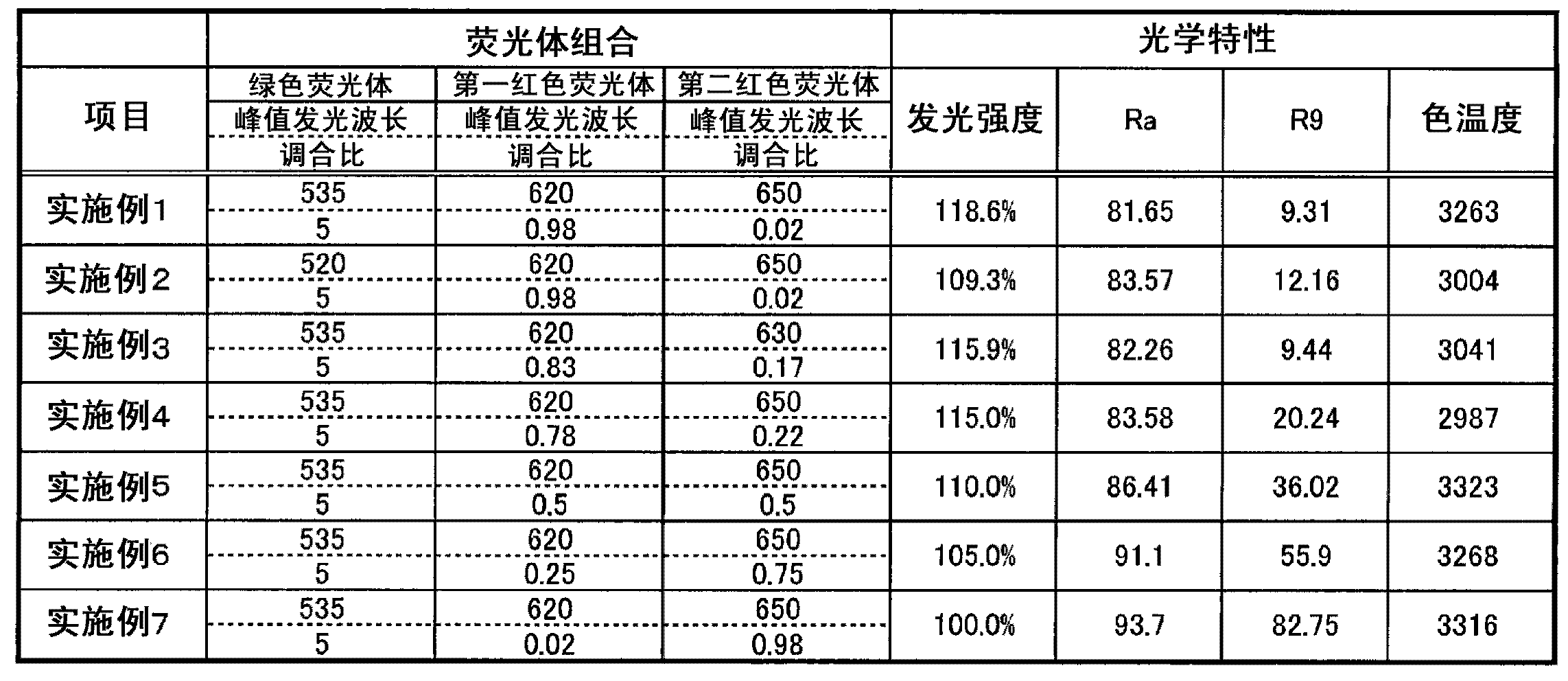Light-emitting device
A technology of light-emitting devices and light-emitting elements, which is applied in the direction of light-emitting materials, lighting devices, electroluminescent light sources, etc., can solve the problems of longer wavelengths and undisclosed issues, and achieve the effects of reduced luminous efficiency suppression and high color rendering
- Summary
- Abstract
- Description
- Claims
- Application Information
AI Technical Summary
Problems solved by technology
Method used
Image
Examples
Embodiment 1
[0064] In Example 1, as the green phosphor, Al having a peak emission wavelength around 535 nm was used. 5 Lu x o y : Ce-based phosphor; (Sr, Ca)AlSiN having a peak emission wavelength around 620nm was used as the first red phosphor 3 : Eu-based phosphor; as the second red phosphor, CaAlSiN having a peak emission wavelength around 650nm is used 3 :Eu-based phosphor. In addition, the mixing ratio of the green phosphor, the first red phosphor, and the second red phosphor was 5:0.98:0.02. The relative value of luminous intensity (based on the lowest luminous intensity in Examples 1-7) is 118.6%, the average color rendering index Ra is 81.65, the special color rendering index R9 is 9.31, and the color temperature is 3263K.
Embodiment 2
[0066] In Example 2, as the green phosphor, Ca which has a peak emission wavelength around 520 nm is used. 3 (Sc, Mg) 2 Si 3 o 12 : Ce-based phosphor; (Sr, Ca)AlSiN having a peak emission wavelength around 620nm was used as the first red phosphor 3 : Eu-based phosphor; as the second red phosphor, CaAlSiN having a peak emission wavelength around 650nm is used 3 :Eu-based phosphor. In addition, the mixing ratio of the green phosphor, the first red phosphor, and the second red phosphor was 5:0.98:0.02. The difference from Example 1 is the peak emission wavelength of the green phosphor and the phosphor material.
[0067] The relative value of luminous intensity is 109.3%, the average color rendering index Ra is 83.57, the special color rendering index R9 is 12.16, and the color temperature is 3004K. Compared with Example 1, the peak emission wavelength of the green phosphor is shortened, so the emission intensity is slightly lowered, but the color rendering property is impro...
Embodiment 3
[0069] In Example 3, as the green phosphor, Al having a peak emission wavelength around 535 nm was used. 5 Lu x o y : Ce-based phosphor; (Sr, Ca)AlSiN having a peak emission wavelength around 620nm was used as the first red phosphor 3 : Eu-based phosphor; (Sr, Ca)AlSiN having a peak emission wavelength around 630nm is used as the second red phosphor 3 :Eu-based phosphor. In addition, the mixing ratio of the green phosphor, the first red phosphor, and the second red phosphor was 5:0.83:0.17. The difference from Example 1 is the peak emission wavelength of the second red phosphor, the phosphor material, and the blending ratio of the first and second red phosphors.
[0070] The relative value of luminous intensity is 115.9%, the average color rendering index Ra is 82.26, the special color rendering index R9 is 9.44, and the color temperature is 3041K. Compared with Example 1, the peak emission wavelength of the second red phosphor is shortened, but because the blending ratio...
PUM
| Property | Measurement | Unit |
|---|---|---|
| Particle size | aaaaa | aaaaa |
| Viscosity | aaaaa | aaaaa |
Abstract
Description
Claims
Application Information
 Login to View More
Login to View More - R&D
- Intellectual Property
- Life Sciences
- Materials
- Tech Scout
- Unparalleled Data Quality
- Higher Quality Content
- 60% Fewer Hallucinations
Browse by: Latest US Patents, China's latest patents, Technical Efficacy Thesaurus, Application Domain, Technology Topic, Popular Technical Reports.
© 2025 PatSnap. All rights reserved.Legal|Privacy policy|Modern Slavery Act Transparency Statement|Sitemap|About US| Contact US: help@patsnap.com



